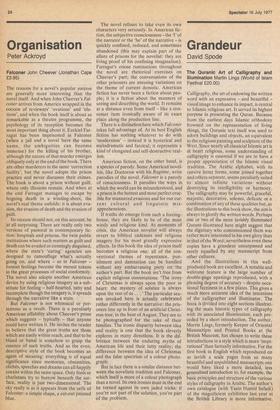Grandeur
David Spode
The CluranIc Art of Calligraphy and Illumination Martin Lings (World of Islam Festival £20.00)
Calligraphy, the art of endowing the written word with an expressive — and beautiful — visual image to enhance its impact, is central to Islamic religious art. It served its highest purpose in presenting the Quran. Because from the earliest days Islamic oithodoxy frowned on the representation of living things, the Quranic text itself was used to adorn buildings and objects, an equivalent to the religious painting and sculpture of the West. Since nearly all classicial Islamic art is at heart religious, some understanding of calligraphy is essential if we are to have a proper appreciation of the Islamic visual tradition. The Arabic alphabet, with its cursive letter forms, some joined together and others separate, seems peculiarly suited to almost infinite variations without destroying its intelligibility or harmony. The calligraphy may be powerful, graceful, majestic, decorative, solemn, delicate or a combination of any of these qualities but, as the illustrations to this book show, the aim is always to glorify the written words. Perhaps one or two of the more lavishly illuminated Qurans illustrated here might suggest that the dignitary who commissioned them was rather more interested in his own glory than in that of the Word; nevertheless even these copies have a grandeur unsurpassed and rarely equalled by any manuscript from other cultures.
And the illustrations in this w ellproduced book are excellent. A notable and welcome feature is the large number of double-page openings reproduced, with a pleasing degree of accuracy — despite occasional fuzziness in a few plates. This gives a much more accurate idea of the intentions of the calligrapher and illuminator. The book is divided into eight sections illustrating the main historic types of calligraphy with its associated illumination, each preceded by a short introduction. The author, Martin Lings, formerly Keeper of Oriental Manuscripts and Printed Books at the British Museum, has chosen to write these introductions in a style which is more 'inspirational' than factually informative. For the first book in English which reproduced on so lavish a scale pages from so many beautiful and unpublished manuscripts one would have liked a more detailed, less generalised introduction to, for example, the basic principles and structure of the various styles of calligraphy in Arabic. The author's own catalogue (with Yasin Hamid Safadi) of the magnificient exhibition last year at the British Library is more informative.


































 Previous page
Previous page